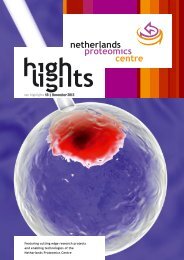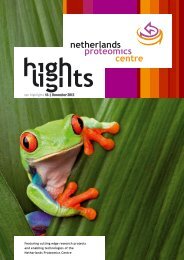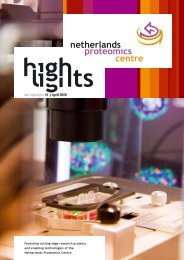NPC Progress Meeting 2012 - Netherlands Proteomics Centre
NPC Progress Meeting 2012 - Netherlands Proteomics Centre
NPC Progress Meeting 2012 - Netherlands Proteomics Centre
- No tags were found...
Create successful ePaper yourself
Turn your PDF publications into a flip-book with our unique Google optimized e-Paper software.
Even more interesting is the different behaviour of variousisoenzymes, as is observed, for example, for the phosphoglucomutasesPGM1 (YKL127W) and PGM2 (YMR105C) in the upperpart of Figure 3.From yeast to mice The methods described above werespecifically developed for yeast proteins. However, similar approachescan be adopted to create assays for other organisms,as long as sequence information (and preferably MS/MS information)is present or can be obtained experimentally. We arecurrently developing assays to measure the effect of ageing inthe mouse proteome.References1 Partridge, L. (2011) Some highlights of research on ageingwith invertebrates 2010. Ageing Cell 10 (1), 5-9.2 Domon, B. and Aebersold, R. (2010) Options and considerationswhen selecting a quantitative proteomics strategy.Nature Biotechnology 28 (7), 710-721.3 Lange, V. et al. (2008) Selected reaction monitoring forquantitative proteomics: a tutorial. Molecular SystemsBiology 4 (222), 1-14.4 Picotti, P. et al. (2009) Full dynamic range proteome analysisof S. cerevisiae by targeted proteomics. Cell 138 (4),795-806.| 19Figure 3 | Metabolic pathways in yeast measured with targeted proteomics. Relative proteinconcentrations in yeast cultures at various growth phases for proteins involved in the glycolysis andgluconeogenesis pathway (according to the KEGG database (www.kegg.jp)). The three coloured blocksindicate the ratios of the ( 14 N) mid-exponential growth phase (14M), the diauxic shift (14D) and thestationary phase (14S) versus the ( 15 N) standard culture. Ratio colours range from dark red (2) indicatingthat the protein is abundant.Research teamUniversity of Groningen: Karin Wolters, postdoc at theSystems Biology <strong>Centre</strong>; Hjalmar Permentier, head of the MassSpectrometry <strong>Centre</strong>; and Rainer Bischoff, chair Analysis ofBiological Macromolecules.ContactProf. Dr. Rainer BischoffGroningen Research Institute of PharmacyAnalytical BiochemistryAntonius Deusinglaan 19713 AV Groningen, the <strong>Netherlands</strong>T +31 50 363 3338r.p.h.bischoff@rug.nlsummaryTargeted proteomics has great potential for studying thechange of protein levels in biological processes more robustlythan discovery-based proteomics. The presented example ofprotein abundances in the yeast glycolysis pathway in variousgrowth phases illustrates the wealth of information that canbe obtained. These data will be combined with metabolomicsdata and single cell analyses to create a more comprehensiveimage of replicative ageing in yeast in a systems biologyapproach. Our study of the changes in protein levels duringreplicative ageing in the mother cells is part of a concertedeffort to study the molecular mechanisms of replicativeageing at both the single cell and the population level at theSystems Biology <strong>Centre</strong> for Metabolism and Ageing (SBC-EMA,one of three national systems biology centres funded bythe <strong>Netherlands</strong> Organisation for Scientific Research). Dataon protein and metabolite levels are obtained by MS-basedtargeted proteomics and metabolomics. This approach will beextended to study the effect of environmental conditions suchas dietary changes and other stress conditions.






